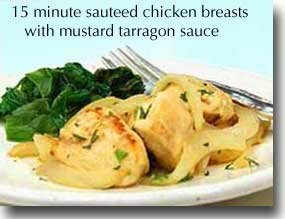Today's Recipe
If you don't know what to serve for dinner tonight ...
Try this quick-and-easy recipe that combines the great tastes of chicken, Dijon mustard and tarragon to your Healthiest Way of Eating. Fresh herbs are a great way to enhance the taste of your meals and enjoy extra health-promoting nutrients as well.

Ingredients:
- 1 medium onion cut in half and sliced medium thick
- 5 medium cloves garlic, pressed
- 2 boneless, skinless chicken breasts, cut into 1-inch pieces
- 3 TBS Dijon mustard
- 1 TBS + 1/2 cup chicken broth
- 2 tsp honey
- 1 TBS chopped fresh tarragon (or 1 tsp dried tarragon)
- 2 TBS chopped fresh parsley (or 2 tsp dried parsley)
- salt and white pepper to taste
- Slice onion and press garlic and let sit for 5-10 minutes to bring out their hidden health benefits.
- Heat 1 TBS broth in a 10-12 inch stainless steel skillet. Healthy Sauté onion in broth over medium heat for 2 minutes.
- While onions are sautéing, cut chicken into pieces. Add chicken pieces and continue to sauté for another 3 minutes, stirring frequently to seal chicken on all sides. Add garlic and continue to sauté for another minute.
- Add mustard, 1/2 cup broth, and honey. Mix thoroughly and simmer uncovered for about 7-8 minutes on medium-high heat stirring occasionally to cook chicken evenly. This will also reduce sauce.
- While chicken is cooking, chop herbs and add at end with salt and pepper to taste.
- Mediterranean Swiss Chard
In-Depth Nutritional Profile for 15-Minute Sautéed Chicken Breasts with Mustard and Tarragon
Healthy Food Tip
What do you think about cooking vegetables in a microwave?
We get many questions about whether we recommend cooking vegetables in a microwave. As you will see throughout our website, light steaming is our cooking method of choice for most vegetables. Loss of nutrients in the microwave depends on the same factors involved with loss of nutrients on the stovetop.
To predict the nutrient loss, it's important to know answers to questions like: "Is the vegetable placed in water? How much water? To what temperature are the vegetable and water heated? For how long? We've seen studies showing minimal loss of nutrients from microwaved vegetables, and we've also seen studies showing substantial loss. In general, we prefer stovetop steaming that can be accomplished in as little time as microwaving while providing a more even heat.



No comments:
Post a Comment